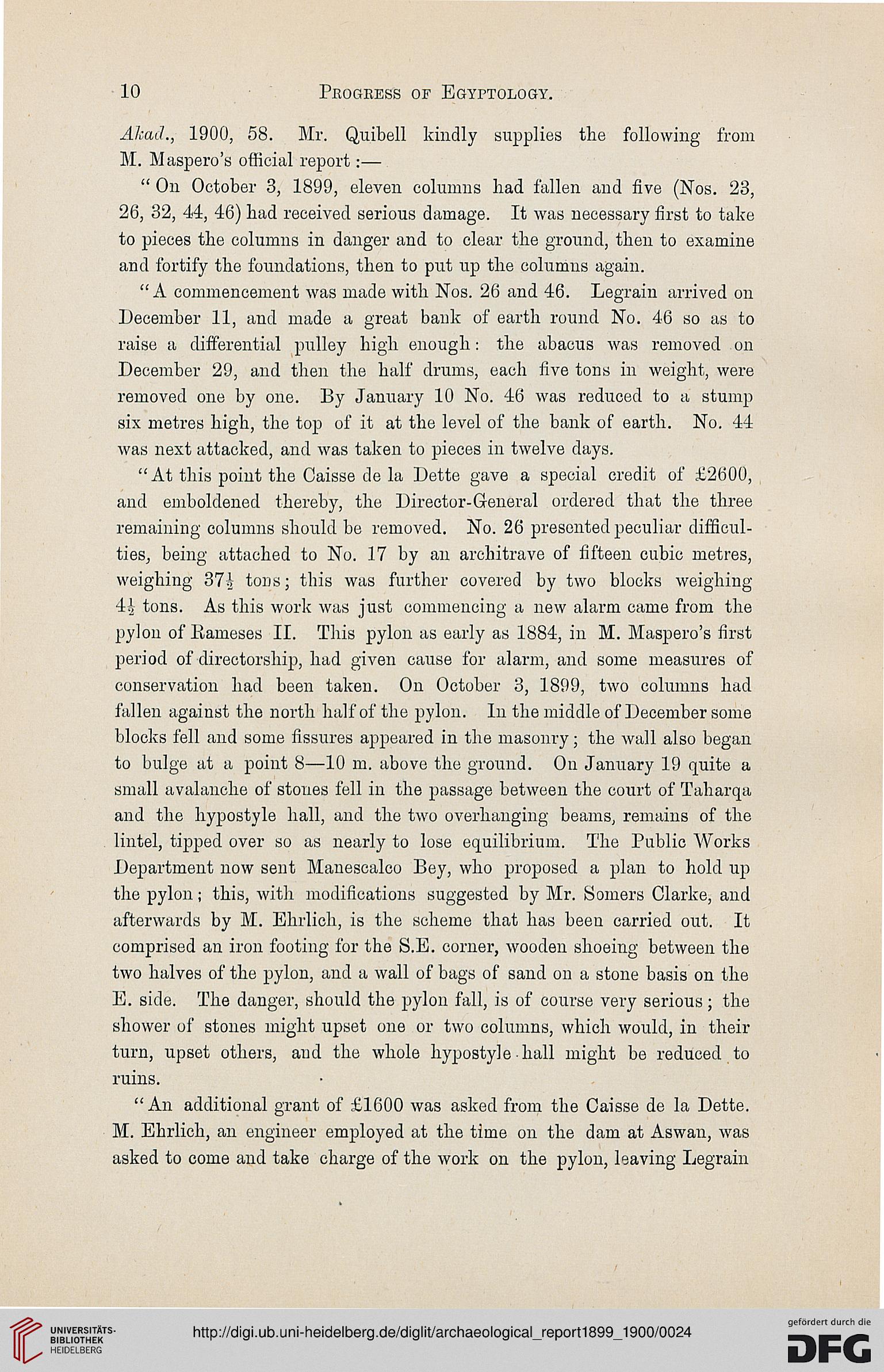to
Progress of Egyptology.
AkaJ., 1900, 58. Mr. Quibell kindly supplies the following from
M. Maspero's official report ■—
" On October 3, 1899, eleven columns had fallen and five (Nos. 23,
26, 32, 44, 46) had received serious damage. It was necessary first to take
to pieces the columns in danger and to clear the ground, then to examine
and fortify the foundations, then to put up the columns again.
"A commencement was made with Nos. 26 and 46. Legrain arrived on
December 11, and made a great bank of earth round No. 46 so as to
raise a differential pulley high enough: the abacus was removed on
December 29, and then the half drums, each five tons in weight, were
removed one by one. By January 10 No. 46 was reduced to a stump
six metres high, the top of it at the level of the bank of earth. No. 44
was next attacked, and was taken to pieces in twelve days.
"At this point the Caisse de la Dette gave a special credit of £2600,
and emboldened thereby, the Director-General ordered that the three
remaining columns should be removed. No. 26 presented peculiar difficul-
ties, being attached to No. 17 by an architrave of fifteen cubic metres,
weighing 37A tons; this was further covered by two blocks weighing
4A tons. As this work was just commencing a new alarm came from the
pylon of Barneses II. This pylon as early as 1884, in M. Maspero's first
period of directorship, had given cause for alarm, and some measures of
conservation had been taken. On October 3, 1899, two columns had
fallen against the north half of the pylon. In the middle of December some
blocks fell and some fissures appeared in the masonry; the wall also began
to bulge at a point 8—10 m. above the ground. On January 19 quite a
small avalanche of stones fell in the passage between the court of Taharqa
and the hypostyle hall, and the two overhanging beams, remains of the
lintel, tipped over so as nearly to lose equilibrium. The Public Works
Department now sent Manescalco Bey, who proposed a plan to hold up
the pylon; this, with modifications suggested by Mr. Somers Clarke, and
afterwards by M. Ekrlioh, is the scheme that has been carried out. It
comprised an iron footing for the S.E. corner, wooden shoeing between the
two halves of the pylon, and a wall of bags of sand on a stone basis on the
E. side. The danger, should the pylon fall, is of course very serious; the
shower of stones might upset one or two columns, which would, in their
turn, upset others, aud the whole hypostyle hall might be reduced to
ruins.
"An additional grant of £1600 was asked from the Caisse de la Dette.
M. Ehrlich, an engineer employed at the time on the dam at Aswan, was
asked to come and take charge of the work on the pylon, leaving Legrain
Progress of Egyptology.
AkaJ., 1900, 58. Mr. Quibell kindly supplies the following from
M. Maspero's official report ■—
" On October 3, 1899, eleven columns had fallen and five (Nos. 23,
26, 32, 44, 46) had received serious damage. It was necessary first to take
to pieces the columns in danger and to clear the ground, then to examine
and fortify the foundations, then to put up the columns again.
"A commencement was made with Nos. 26 and 46. Legrain arrived on
December 11, and made a great bank of earth round No. 46 so as to
raise a differential pulley high enough: the abacus was removed on
December 29, and then the half drums, each five tons in weight, were
removed one by one. By January 10 No. 46 was reduced to a stump
six metres high, the top of it at the level of the bank of earth. No. 44
was next attacked, and was taken to pieces in twelve days.
"At this point the Caisse de la Dette gave a special credit of £2600,
and emboldened thereby, the Director-General ordered that the three
remaining columns should be removed. No. 26 presented peculiar difficul-
ties, being attached to No. 17 by an architrave of fifteen cubic metres,
weighing 37A tons; this was further covered by two blocks weighing
4A tons. As this work was just commencing a new alarm came from the
pylon of Barneses II. This pylon as early as 1884, in M. Maspero's first
period of directorship, had given cause for alarm, and some measures of
conservation had been taken. On October 3, 1899, two columns had
fallen against the north half of the pylon. In the middle of December some
blocks fell and some fissures appeared in the masonry; the wall also began
to bulge at a point 8—10 m. above the ground. On January 19 quite a
small avalanche of stones fell in the passage between the court of Taharqa
and the hypostyle hall, and the two overhanging beams, remains of the
lintel, tipped over so as nearly to lose equilibrium. The Public Works
Department now sent Manescalco Bey, who proposed a plan to hold up
the pylon; this, with modifications suggested by Mr. Somers Clarke, and
afterwards by M. Ekrlioh, is the scheme that has been carried out. It
comprised an iron footing for the S.E. corner, wooden shoeing between the
two halves of the pylon, and a wall of bags of sand on a stone basis on the
E. side. The danger, should the pylon fall, is of course very serious; the
shower of stones might upset one or two columns, which would, in their
turn, upset others, aud the whole hypostyle hall might be reduced to
ruins.
"An additional grant of £1600 was asked from the Caisse de la Dette.
M. Ehrlich, an engineer employed at the time on the dam at Aswan, was
asked to come and take charge of the work on the pylon, leaving Legrain





